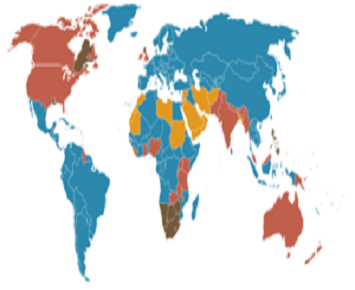Live in USA
 |
A common law legal system is a system of law characterized by case law which
is law developed by judges through decisions of courts and similar tribunals.1
Common law systems also include statutes enacted by legislative bodies, though
those statutes typically either codify judicial decisions or fill in areas of
the law not covered by case law. In contrast to common law systems, civil law
(codified/continental law) systems are founded on a set of legal codes,2 which
are organized laws that attempt to cover exhaustively the various legal domains,
and is characterized by an absence of precedent in the judicial application of
those codes.3 In the modern period, both systems tend to include administrative
regulations which may also be codified.4
A common law system is a legal
system that gives great potential precedential weight to common law,5 on the
principle that it is unfair to treat similar facts differently on different
occasions.6 The body of precedent is called "common law" and it binds future
decisions. In cases where the parties disagree on what the law is, a common law
court looks to past precedential decisions of relevant courts. If a similar
dispute has been resolved in the past, the court is usually bound to follow the
reasoning used in the prior decision (this principle is known as stare decisis).
If, however, the court finds that the current dispute is fundamentally distinct
from all previous cases (called a "matter of first impression"), judges have the
authority and duty to make law by creating precedent.7 Thereafter, the new
decision becomes precedent, and will bind future courts.
In practice, common
law systems are considerably more complicated than the simplified system
described above. The decisions of a court are binding only in a particular
jurisdiction, and even within a given jurisdiction, some courts have more power
than others. For example, in most jurisdictions, decisions by appellate courts
are binding on lower courts in the same jurisdiction, and on future decisions of
the same appellate court; but decisions of lower courts are only non-binding
persuasive authorities. Interactions between common law, constitutional law,
statutory law and regulatory law also give rise to considerable complexity.
However, stare decisis, the principle that similar cases should be decided
according to consistent principled rules so that they will reach similar
results, lies at the heart of all common law systems.
One third of the
world's population (approximately 2.3 billion people) live in common law
jurisdictions or in systems mixed with civil law. Particularly common law is in
England where it originated in the Middle Ages,8 and in countries that trace
their legal heritage to England as former colonies of the British Empire,
including India,9 the United States (with the partial exception of Louisiana10),
Pakistan,11 Nigeria, Bangladesh, Canada (with the exception of Quebec, which
uses a mix of civil law in areas of provincial jurisdiction and common law in
areas of federal jurisdiction), Malaysia, Ghana, Australia,12 Sri Lanka, Hong
Kong, Singapore, Burma, Ireland, New Zealand, Jamaica, Trinidad and Tobago,
Cyprus, Barbados,13 South Africa, Zimbabwe, Cameroon, Namibia, Liberia, Sierra
Leone, Botswana, Guyana and Israel.
In a common law jurisdiction several
stages of research and analysis are required to determine "what the law is" in a
given situation. First, one must ascertain the facts. Then, one must locate any
relevant statutes and cases. Then one must extract the principles, analogies and
statements by various courts of what they consider important to determine how
the next court is likely to rule on the facts of the present case. Later
decisions, and decisions of higher courts or legislatures carry more weight than
earlier cases and those of lower courts.24 Finally, one integrates all the lines
drawn and reasons given, and determines "what the law is". Then, one applies
that law to the facts.
Download